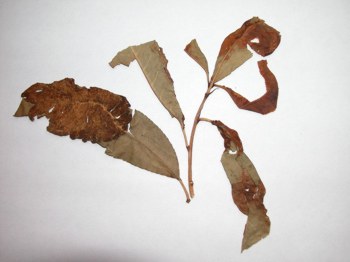Diseases
Taphrina deformans (Berk.) Tul. - Peach Leaf Curl
Systematic position.
Division Ascomycota, class Ascomycetes, order Taphrinales, family Thaphrinaceae, genus Taphrina.Biological group.
This species is a biotroph.Morphology and biology.
The Leaf Curl first appears in spring as reddish spots on developing leaves. These areas become thickened and puckered, causing leaves to curl and severely distort. The thickened areas turn yellowish gray and velvety as spores are produced on the surface by the Leaf Curl fungus. Affected leaves later turn yellow or brown and can remain on the tree or may fall off; they are replaced by a second set of leaves that develop more normally unless wet weather continues. The Leaf Curl pathogen also infects twigs and shoots. Affected shoots become thickened, stunted, distorted, and often die. Only rarely do reddish, wrinkled areas develop on fruit surfaces; later in the season these infected areas become corky and tend to crack. Life cycle takes about 2 weeks after leaves emerge from buds before leaf symptoms appear. The fungus grows between leaf cells and stimulates them to divide and grow larger than normal, causing swelling and distortion of the leaf. Red plant pigments accumulate in the distorted cells. Cells of the fungus break through the surface of distorted leaves and produce elongated, saclike structures called asci (cylindrical with rounded top, 19-26 x 6-12 microns). Inside the asci are spores known as ascospores (3-7 microns, colorless, rounded), which give the leaf a powdery or felt-like appearance. The ascospores are released into the air, carried to new tissues, and bud to form conidia (2.5-6.0 x 4-5 microns). The fungus survives the hot dry summer as conidia and ascospores on the tree.s surfaces. When the weather turns cool and wet in fall, the ascospores germinate to produce conidia. The new conidia and the over-summering conidia continue to increase in number by budding. Eventually a film of conidia forms on the tree.s surface. In spring the conidia are moved by splashing water and can infect newly developed leaves.Distribution.
Development of the epiphytic Peach Leaf Curl (one time in 2 years, incidence is 50-100%) occurs in Georgia, southern Ukraine, Crimea, Moldova, Turkmenistan, Ordubad area of Azerbaijan, central and southern areas of Krasnodar and Stavropol Territories, Adygea, Karachay-Cherkessia, Black Sea area. Areas with moderate development of the Peach Leaf Curl (one time in 3 years, incidence is 30-50%) are the Dagestan, submontane areas of Azerbaijan, Armenia. In the areas of low severity (1 time in 5 years, incidence is 10-30%) the disease develops in Kazakhstan, Kyrgyzstan, northern Rostov Region, Krasnodar and Stavropol Territories.Ecology.
The amount and duration of rainfall, as well as temperature, are the main factors influencing the release of Leaf Curl ascospores, germination, and infection. Optimum temperature for germination of ascospores is 10-21.C and low infection severity occurs under 7.C.Economic significance.
Peach Leaf Curl has economic importance. The loss of leaves results in decreased tree growth and fruit production. In addition, defoliation in spring may expose branches to sunburn injury. Control measures are various, including the use of resistant cultivars, sanitation of orchards, and chemical control.Reference citations:
Aslanov D.B. 1955. Biology of Peach leaf curl (Exoascus deformans Fuck) and its control. Izvestiya AN Turkmen USR (Ashkhabad) 1: 41-46. (In Russian)Babaev G.G. 1973. Mikoflora of peach in Ordubad region of Nakhichevan and improvement of control measures for dangerous diseases. PhD Thesis. Baku: Academy of Azerbaijan, Komarov Botanical institute. 40 p. (In Russian)
James P.W., Hawksworth D.L. 1971. Ainsworth & Bisby.s dictionary of the fungi. 6th edition. Kew: CAB. 663 p.
Kalenich F.S., Myalova L.A., Nagornaya L.B. 1999. Peach leaf curl. Zashchita i karantin rastenii (Moscow: Kolos) 9: 17-18. (In Russian)
Karatygin I.V. 2002. Keys to fungi of Russia. Orders Taphrinales, Protomycetales, Exobasidiales, Microstromatales. Saint Petersburg: Nauka. 134 p. (in Russian)
Kashiya N.I. 1974. The cultivars of peach in Georgia against leaf curl. Resistance of agricultural crops to pests and diseases. Baku: Azerbaijan NII of agriculture. 63-65 p. (In Russian)
Khokhraykov M.N., Dobrozrakova T.L., Stepanov K.M., Letova M.F. 2003. Keys to plant diseases. Saint Petersburg: Lan'. 592 p. (In Russian)
Kornilov A.V. 1977. Peach leaf curl. Zashchita Rastenii (Moscow: Kolos) 12: 57. (In Russian)
Kostyuk P.N., Kolomiets M.K. 1959. Blue sparge for control of Peach leaf curl. In: Mil'nik S.A., ed. In help for agricultural industry. V. 2. Odessa: Odessa Agricultural Institute. 103-107 p. (In Russian)
Kulibaba Yu.F. 1969. The Peach leaf curl. Zashchita Rastenii (Moscow: Kolos) 6: 41-42. (In Russian)
Oganyan E.A., Mkrtchan G.G. 1977. About some diseases of peach in North-East area of Armenia. In: Abramova L.S., ed. Peach. Collection of works. Yerevan: Aiastan. 589-595 p. (In Russian)
Parii I.F., Tkachenko G.S. 1986. Disease of peach leaves. Zashchita Rastenii (Moscow: Kolos) 1: 32. (In Russian)
Paterilo G.A. 1958. Protection from Peach leaf curl. Gardening, winegrowing and winemaking of Moldova 2: 60-61. (In Russian)
Skofertsa G.V. 1990. How to fight against Peach leaf curl. Gardening, winegrowing and winemaking of Moldova 6: 55. (In Russian)
Smolyakova V.M. 2000. Fungal diseases of fruit trees in South Russia. Krasnodar: Vest.. 192 p. (In Russian)
Zakharzhevskaya M.N. 1954. Investigation of Peach leaf curl and working out of its control in Dagestan. In: Zaostrovskii E.N., ed. Works of VNII canning industry, 4. Moscow: Pishchepromizdat. 166-179 p. (In Russian)
© Bilder I.V.


